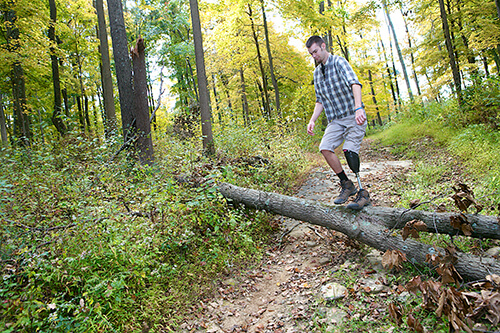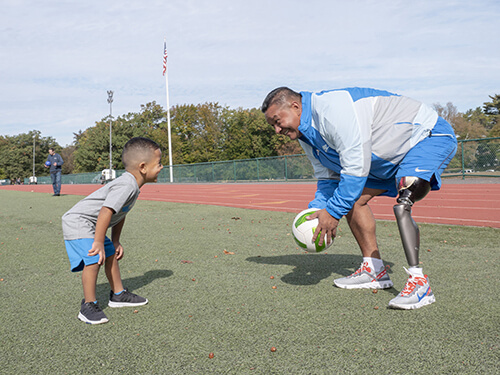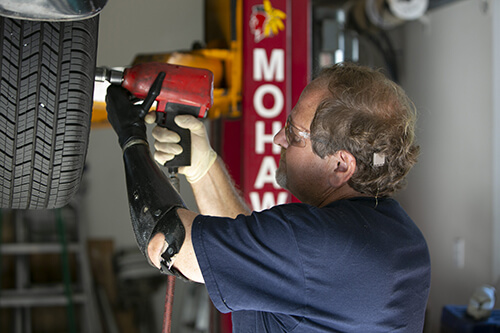No limits following limb loss

“I wanted to do everything, but found I needed to learn to walk before I could run and climb.”
Eric S.
Outdoor enthusiast/Below knee amputee
Adjusting to life after limb loss isn’t easy. The physical, psychological and emotional challenges can be overwhelming. But as individuals move past surgery to rehabilitation, they slowly seek to adapt to their “new normal.”
That process is different for each of the 185,000 individuals who undergo an amputation annually, as well as the more than two million people currently living with limb loss across the U.S. Yet they all have one thing in common: the desire to return to previous activities.
“One of the first questions patients ask is ‘when will I be able to play golf, go fishing, dance, garden or take a swim?’ Then they pause and wonder if – and how – that will ever happen. It may seem impossible at first, but it’s our job to make their goals a reality,” says Mary Beth Ryan, physical therapist, Kessler Institute for Rehabilitation.
“No artificial limb can replace what is lost ... However, aggressive rehabilitation and appropriate prosthetic provision will enhance the ability of injured individuals to pursue athletic activities once again.”
John R. Fergason, CPO and Peter D. Harsch, CP
Textbooks of Military Medicine: Care of the Combat Amputee
Amputation, the surgical removal of a limb, is the result of a traumatic injury, vascular disease, complications from diabetes, infection, cancer or other conditions. It can happen to anyone, at any age or stage of life. And it can be life-changing. That’s why advanced, individualized care is critical in helping amputees adapt to life ahead.
Rehabilitation focuses on healing the remaining part of the limb or residual limb, managing pain and building strength, skills and balance. It involves helping the patient overcome an often profound sense of loss and understand that while things will be different, there really are no limits to what they can achieve.
A team of rehabilitation specialists – doctors, nurses, physical and occupational therapists, psychologists and prosthetists – work with patients to identify their lifestyle needs and recreational interests. These factors are important in determining if a patient is an appropriate candidate for a prosthesis (artificial limb) and the type of device that would be best for them.
“Prosthetic technology has advanced dramatically in recent years. Bionic limbs, robotic and microprocessor components, 3-D printing and the use of lighter weight, more durable materials like titanium are expanding the options for amputees of all ages. These innovations offer greater control and function, a more natural gait and improved motor skills... and allow for increased participation in work, school and leisure activities,” explained Joe Reda, director, Kessler Prosthetic & Orthotic Services.
Most important is having the right prosthesis, one that is properly designed and fitted and matched to an individual’s needs. However depending on a person’s competitive level, sports-specific prostheses are also available, including running blades, foot, ankle and knee components for skiers, snowboarders and cyclists, foot modules for rock climbers and adaptive grips and wrist and elbow components for golfers and ball players.

“Concéntrese en toto lo que tienne, no en lo que ha perdido.” (Focus on all that you have, not what you’ve lost.)
Weimar M.
Soccer fan, salsa dancer/Above knee amputee
Education and training on the safe use and maintenance of the prosthesis are also essential. So is the support of family, friends and others living with limb loss. Cynthia Macaluso, P.T., who runs the amputee support group at Kessler Institute for Rehabilitation, notes that participants typically get the best tips and ideas from others who have ‘been there, done that.’ They know firsthand what works and what doesn’t. That perspective can be extremely helpful to individuals at all stages post-injury.”
Another useful resource is the Amputee Coalition (www.amputee-coalition.org). This national organization provides a wealth of information on adaptive sports, as well as programs, services and support to those living with limb loss.
Above all, individuals with limb loss are reminded that while they can do most anything, it may take a little longer, necessitate a new or different approach and require greater patience and understanding. However, crossing the finish line, sinking a hole-in-one or simply having the best garden on the block can make all the difference – physically and emotionally.

“It can be difficult and frustrating. Every day there’s a new challenge, but also a new milestone.”
Gary H.
Master mechanic/Below elbow amputee